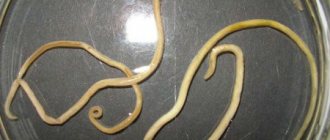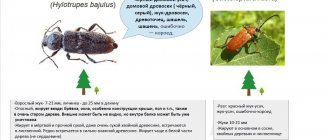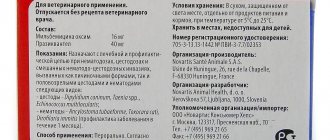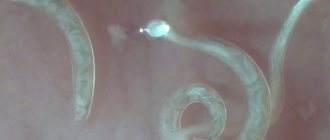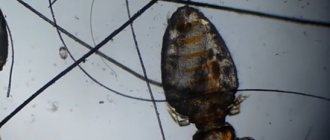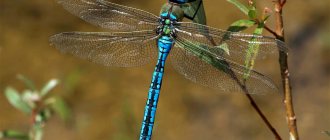Worms are a common condition found in cats. Not only animals that go outside become infected with them, but also those that lead a domestic lifestyle. Infection occurs when a cat comes into contact with the owner's shoes or with other objects brought from the street and inseminated with worm eggs. Infection of a pet leads to dysfunction in the body, but it is worth remembering that the same parasites can also infect the owner.
In this article we will look at the main types of worms in cats, which can cause harm not only to the pet itself, but also to its owner. The topic of treating these parasites will also be briefly touched upon.
What to do in such a situation? To get started, we recommend reading this article. This article describes in detail methods of controlling parasites. We also recommend that you consult a specialist. Read the article >>>
Causes of worms in cats and kittens
The main reason for the appearance of worms in mustachioed pets is the ingestion of parasite eggs into the cat’s body. This can happen in the following ways:
- eating fish and meat products without prior heat treatment;
- communication with other representatives of the cat family (as well as dogs) – carriers of worms;
- through insects - fleas, flies, mosquitoes;
- through rodents (helminth eggs may be on their skins);
- quenching thirst from a dirty pond;
- through the owner's shoes;
- “picking up” eggs from grass, ground and other surfaces.
Note: kittens can become infected with helminths from their mother through milk or even in utero, so it is important to promptly deworm cats before pregnancy.
Scheme of infecting a cat with the most common worms - roundworms of the genus Ascaris
Cucumber tapeworm
One of the most common tape parasites in cats and dogs (it is more common in dogs). In addition, the worm is very dangerous, as it can cause severe intoxication in the body of a sick animal.
The Latin name of the pathogen is dipylidium caninum. The body of the parasite consists of many small segments capable of independent movement for about a day. The body length of an adult individual can reach two meters (in the body of a cat, the worm rarely grows more than half a meter). Infection very often occurs when a cat eats small rodents, as well as as a result of bites from blood-sucking ectoparasites.
The infection is quite severe. In particular, sick pets often vomit and develop chronic diarrhea, occasionally interspersed with periods of constipation. The pet's feces turn out to be saturated with segments of the parasite, which in appearance resemble grains of rice. If you see similar formations in your bed where your cat was previously lying, take him to the vet immediately! As we have already mentioned, the segments are capable of moving independently for some time , and therefore they can be found even under the pillow, not to mention other places in your home! Note that during movement the segments contract, squeezing out hundreds of eggs along the way. So, if there is at least one sick animal in the house, the number of parasite eggs constantly present in the house can reach hundreds of thousands!
Thus, to prevent subsequent infections, it is highly recommended to regularly wet clean rooms with chlorine bleach in “shock” doses. It is also necessary to take a responsible approach to the process of completely eliminating fleas.
Why are worms dangerous for cats?
Developing in the cat’s body, worms cause enormous harm to the animal’s body. Firstly, they injure the mucous membrane of the digestive tract mechanically - they gnaw and pierce the intestinal walls with their spines and teeth. Penetrating into organs, they disrupt the structure of tissues and cells, limiting their functional activity. Sometimes the worms multiply to such an extent that they block the lumen of the small intestine, causing its obstruction.
The damaged tissues of the organs in which the parasites live gradually decompose. The released toxic compounds are carried by the bloodstream, leading to poisoning of the entire animal’s body. In addition, the worms themselves release toxins during their life processes and during decomposition after death within the body.
If a cat has worms, its immune system is severely affected. A weakened pet is unable to fight other infections, which is the cause of the development of various bacterial, viral and fungal diseases.
In the case of abundant reproduction of worms, the animal’s psyche also undergoes significant changes. Constant itching, pain and other sensations lead to the fact that the cat becomes nervous and irritable, its sleep is disturbed and its appetite disappears.
Complications after taking antihelminthics
The development of undesirable reactions can be caused by several factors, for example, the general condition of the animal’s body, incorrectly selected dosage, and others.
The most common complications:
- Intoxication. Occurs when taking an incorrect (exceeded) dose or low-quality medicine. When an animal retains stool, dead worms begin to decompose in the intestines, which leads to the development of complications.
- Individual intolerance to the components of the drug. It can be accompanied by a whole cascade of symptoms: swelling of the muzzle, difficulty breathing, lack of urination, vomiting and others. If such symptoms develop after taking the drug, you must immediately take your pet to the veterinarian.
Symptoms of worms in cats
By what signs can one suspect the presence of worms in cats? First of all, the owner should pay attention to the following symptoms:
A cat's bloated belly may be a sign of worm infection.
- change in eating behavior - the cat begins to eat more than usual without gaining weight, or, on the contrary, even refuses its favorite food;
- disturbances in the functioning of the digestive tract - difficult bowel movements alternate with diarrhea, pieces of undigested food are present in the stool, which indicates a malfunction in the enzyme system;
- anemia, weakness;
- the animal often licks the anal area due to itching;
- the hairline becomes dull, the fur falls out and becomes disheveled;
- mucous membranes acquire a yellow tint due to damage to the liver and gallbladder;
- the abdomen noticeably increases in volume;
- sometimes a cough occurs (a sign of worms entering the respiratory tract);
- Blood and mucus may be present in the stool.
Attention: the owner must remember that similar symptoms can occur with other diseases. If you give your cat an anthelmintic without laboratory confirmation of helminthiasis, this may lead to a worsening of its condition.
HOOKYLOSTOMIS
Ancylostoma tubaeforma is a hookworm, a small round helmin of the Chromadorea class, 1-2 cm long, which has two chitinous plates with three hook-shaped teeth on the oral capsule for fixation in the intestine.
Routes of infection
- Ingestion of larvae with food (feed).
- Active penetration of larvae through the skin.
- Hunting for rodents, in which the larvae can remain viable for up to 10 months.
Life cycle
Hookworm is a geohelminth
.
The eggs hatch into larvae after 10 days in the soil. If the larva enters the cat’s digestive tract with food, it quickly develops into an adult, sexually mature individual. When introduced through the skin, the larva travels a long way through the circulatory system, reaching the respiratory system and bronchi, rises up to the pharynx and is swallowed by the animal into the stomach. From them, adult individuals develop, which are attached by hooks to the intestinal wall. The hookworm is a hematotroph
- it feeds on blood. One infected cat can harbor up to several hundred hookworms. The females of the parasite lay a huge number of eggs every day, which fall into the soil with the animal’s feces.
The definitive host for Ancylostoma tubaeforma is the cat.
The paratenic host for Ancylostoma tubaeforma is rodents
Humans are not infected with this type of hookworm. Ancylostoma duodenale is pathogenic for humans.
Symptoms
The most dangerous symptom of hookworm infection is chronic blood loss with the development of anemia
. The sites of helminth penetration in the small intestine constantly bleed. With mass infestation, feces may become black (melena), and there may be profuse bleeding that threatens the life of the animal. A blood test shows a decrease in hemoglobin, the number of red blood cells and an increase in reticulocytes, as the red bone marrow tries to compensate for blood loss. In addition, the attachment of the parasite to the intestinal wall causes inflammation, which is manifested by enteritis, indigestion, diarrhea, the animal loses weight, protein-mineral metabolism is disrupted, and general health and coat condition deteriorate.
Diagnosis of helminthic infestations
It is not difficult to guess that a domestic cat has worms if they (or their particles) come out along with feces or vomit.
Otherwise, if the above symptoms appear, and also periodically as a preventive measure, you should contact a veterinary clinic for diagnosis. It is better if the owner brings the animal directly to the veterinarian, because feces alone are in most cases not enough to detect parasites. This may be due both to the localization of helminths and to their insufficient maturity, when the worms are not yet able to lay eggs. Your pet's blood will be taken for laboratory testing and, if necessary, a sputum test will be prescribed. In some cases, the doctor may refer the cat for an X-ray examination of the lungs or an ultrasound examination of the liver and heart. In the process of identifying helminthiasis, they are differentiated from diseases of internal organs, poisoning, and colds.
Trematodes
This is the name given to worms belonging to the category of “flukes”. They live, as a rule, in the liver, although there are types that “huddle” in the bladder and other internal organs of the cat. But the “classics” are still considered to be species that live in the liver of animals.
Many varieties of trematodes have a rather complex life cycle, including development in the body of rodents, freshwater mollusks and fish . The main symptom indicating the presence of trematodes in a cat’s body is a variety of problems with the latter’s liver. This is indicated by yellowed skin and visible mucous membranes of the pet. In addition, when trying to palpate the right hypochondrium of the animal, the latter may react inadequately to this, since the cat will be in great pain.
Treatment of worms in cats
Treatment of worms in representatives of the cat family is carried out comprehensively and consists of solving several problems:
- destroy parasites;
- ensure their rapid removal from the animal;
- detoxify the body;
- restore immunity and functional activity of damaged organs.
For this purpose, anthelmintic drugs are used, which can be intended for both internal and external use. The products are available in different forms: deworming tablets, suspension, injections, drops.
Antihelminthics for cats for oral administration
Lungworm cycle
Medicines for deworming in cats intended for internal use have different effects on parasites. Some destroy the integumentary tissues and shells of eggs, others negatively affect the nervous structures, leading to paralysis of the helminth, and others disrupt metabolism. In addition, some drugs act only on adults, while others destroy larvae and eggs.
In accordance with the components included in the medications for worms, they are divided into broad-spectrum drugs and those aimed at exterminating only one type of helminth. The latter can be used only after an accurately established diagnosis.
Among the most common complex preparations for worms in cats are:
- Milbemax;
- Prasintel;
- Drontal;
- Prazicide;
- Fenasal.
When ridding your pet of worms, you need to carefully monitor its condition. Mass death of parasites can lead to severe intoxication of the cat, especially if there are significant numbers of them. An animal weakened by helminths may experience vomiting and diarrhea. You can help your pet with absorbent agents: you need to give activated carbon, enterosgel or others.
Deworming products for external use
External medications for helminths in cats are presented in the form of drops that are applied to the withers. These are: Bars, Profender, Drontsid and others. Such funds have both pros and cons. The first is ease of use, the main thing is that the animal cannot lick the place where the drops are applied. In addition, such a medicine destroys not only internal, but also external parasites - fleas and ticks, and also serves as a preventive measure for their appearance.
Among the disadvantages, the effect of the medicine is not strong enough, especially with a significant number of helminths. Drops are absolutely useless to use for helminthiasis caused by trematodes; the greatest effect is achieved if the disease in a cat is provoked by nematodes.
Injections for worms
In difficult cases, the veterinarian will prescribe anti-worm injections for the cat - Ivomec or Ivermec. The procedures will need to be carried out in a clinical setting, since preparing the solution yourself can lead to errors in dosage and the death of the animal.
Attention: the injection form of the medicine is not a prophylactic agent.
Preventive actions
Let us immediately warn you that it is almost impossible to be 100% insured against the penetration of parasitic worms into your pet’s body. To begin with, many types of worms can be transmitted from animal to animal through the bites of fleas and other ectoparasites. In addition, insects can be mechanical carriers of parasite eggs.
The latter, by the way, for the most part have an enviable degree of resistance in the external environment, being able to maintain their virulence (the ability to infect) for months and even years. They are especially durable in indoor conditions, since eggs there are not affected by UV radiation and other “aggressive” environmental factors. Thus, when purchasing used care items, you must thoroughly wash and disinfect them. If the cat is already undergoing treatment for helminth infections, it is necessary to constantly wash and disinfect the room in which he is constantly located.
If you take a cat from a nursery/shelter “in addition” to your existing pets, both it and your cats must be treated with anthelmintic drugs. Practice clearly proves that in places where pets are kept crowded, the degree of infection by helminthic diseases can easily reach 100%.
Let us once again emphasize the importance of protecting pets from fleas . How to achieve this with maximum results and minimum costs? There is one simple folk remedy. Sagebrush. Place its fresh or dried leaves in your cat's basket and place them in secluded corners of your home. Fleas are not guaranteed! The same effect can be obtained by using wormwood essential oil. You can buy it at any pharmacy. You can treat your pet's fur with the same composition (but no more than a couple of drops). It must be applied in places where the animal cannot lick the drug (it is extremely bitter).
Prevention of helminthiasis
To prevent the appearance of worms in cats, it is enough to adhere to the following preventive rules.
- Avoid contact of your pet with unfamiliar or infected animals.
- When returning from the street, put your shoes in a separate closed place, not allowing the cat to sniff them. Wipe the hallway floor several times a day using disinfectants.
- Regardless of whether the cat goes outside or not, treat it with external products against fleas and other parasites.
- Eliminate raw fish from your mustachioed friend’s diet.
- Wash the tray and food bowl thoroughly and regularly.
Which cat worms can be transmitted to humans?
Take preventive measures when interacting with a cat, especially if you suspect the presence of worms
Although cats can be hosts to many types of helminths, not all of them are able to take up residence in the human body. For example, flukes pose a threat to the health of the owner: liver, pulmonary and other types. These worms “settle” in the internal organs of a person (liver, lungs), leading to disruption of their functions, tissue decay, hemorrhages, and even death.
Tapeworms, such as alveococcus, cucumber tapeworm and others, can also lead to the death of the owner. Anemia, allergies, blindness, death are the consequences of a person being infected by a cat with roundworms and nematodes.
It is especially important to prevent infection of children in families with cats. It is necessary to explain to the child why you should not kiss an animal, that after contact with it you need to wash your hands with soap, that you should not pet stray kittens on the street, and so on.
General information
It is believed that the youngest and, conversely, the oldest animals are most prone to the appearance of parasites. This is due to the fact that their immune system can no longer adequately respond to threats from the external environment, including the eggs of parasitic worms. In our climatic conditions, nematodes are the most common, since their eggs are the most resistant to seasonal temperature changes. However, parasitological specialists are inclined to believe that the widespread distribution of parasitic species of nematodes in nature . Flatworms in cats are not so common, but the possibility of infection with them cannot be ruled out.
The route of infection is most often nutritional, through contaminated food or water. In more rare situations, a transmissible type of infection is noted (through the bites of blood-sucking ectoparasites). In particular, this is how the cucumber tapeworm spreads. Remember that parasite eggs can persist indoors for a very, very long time. On the street they are not so durable, since there they are affected by UV radiation from sunlight, temperature changes and other negative environmental factors.
How to give your cat deworming medicine
Many owners are faced with the problem of how to give a pill to a cat. Pets resist in every possible way the owners’ attempts to open their mouths and push an incomprehensible bitter thing into it. To prevent physical and mental injury on both sides, you can use a number of proven techniques:
- crush the tablet into powder and pour it into your mouth;
- dissolve the tablet in a small volume of water, draw it into a syringe and pour it into the cat’s mouth;
- use the tablet dispenser.
How to properly rid a cat of worms
In order for your pet to be treated for helminths with the greatest effectiveness, firstly, you should carefully study the instructions for the medicinal product. It is important to strictly follow the dosage recommended by the veterinarian or the annotation (in case of self-therapy). Before starting treatment for helminthic infestation, the animal must be treated for external parasites.
Some cats manage to hold the pill in their mouth and then spit it out, so the owner must not only place the medicine in the pet's mouth, but also make sure that it is swallowed.
In most cases, deworming medication is given to the cat twice, with an interval of two weeks. This is due to the life cycle of parasites. If the disease is advanced, the doctor may prescribe longer therapy.
After deworming, you must make sure that the activities were successful. This will require repeated control tests.
When not to deworm
There are several situations when you need to wait a little while treating cats for worms:
- serious condition of the pet;
- exacerbation of infectious diseases;
- cat pregnancy;
- lactation period;
- newborn kittens (usually age restrictions are indicated in the annotation for the drug).
It may also be difficult to deworm an aging cat. At this age, an animal should be treated for worms only in consultation with a specialist.

